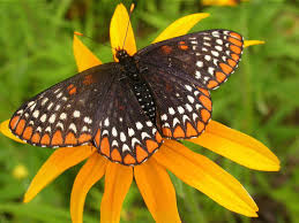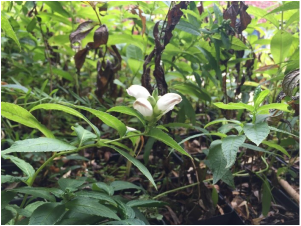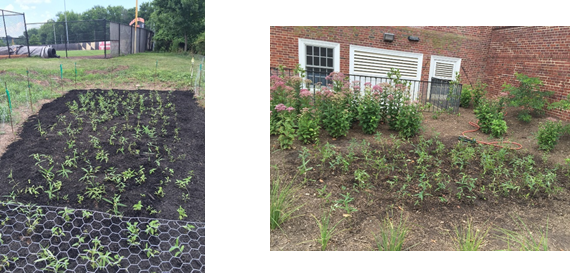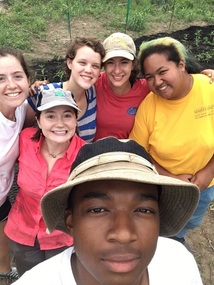Environmental Science and Policy and Spanish
While the Diamondback Terrapin is idolized at the University of Maryland as our mascot and state reptile, our state insect -the Baltimore Checkerspot Butterfly (Euphydryas phaeton)- is left in the dust. The Baltimore Checkerspot is included on the List of Rare, Threatened, and Endangered Animals produced by the Maryland Department of Natural Resources in 2010. At risk of extirpation in Prince George’s County and the state of Maryland due to habitat loss, this precious butterfly needs our help. Thus, during the summer 2016 I joined the vanEngelsdorp Honeybee Lab team with the goal of reintroducing the Checkerspot to campus, and to Prince George’s County. In order to achieve this goal, we first needed to re-establish its specific habitat before hand-raising and releasing butterflies.
Background
The Baltimore Checkerspot Butterfly was named the Maryland’s official state insect in 1973. Decked out in colors similar to the Maryland crest -orange, black and white- the butterfly is primarily black with noticeable, delicately placed white and orange spots bordering the wing.
In order to sustain a healthy population, these insects require specific habitat conditions that enable certain population dynamics. The butterfly only feeds on one host plant, the White Turtlehead (Chelone glabra), which grows in stream-fed meadows with small trees and shrubs. Moreover, the phrase “metapopulation dynamics” best describes how a Baltimore Checkerspot population within an area is divided into sub-populations along a network of habitat patches. Thus, an appropriate habitat that meets their needs is vital to their survival
Conservation Status
According to the Maryland Department of Natural Resources, the butterfly has a conservation status rank of S2, or imperiled due to its rarity. Traditionally located in 15 counties throughout the state of Maryland, Checkerspot colonies are now only found in 7 counties and 11 sites total. Moreover, despite wild colonies living in Prince George’s County -at which the University of Maryland is located- from the 1960s-2006, the current population in this county is nearly extirpated.

Past Project
Prior to me joining the lab the summer of 2016, Carin Celebuski -UMD’s former volunteer coordinator- led a group of undergraduates to conduct research on the butterfly, the first step in the process of reintroduction to campus. As a result, a Launch UMD campaign was brought about to raise funds for this exciting project. It was so successful that it exceeded its goal of $5,000.
Following the successful fundraising campaign, Carin Celebuski retired. Without a clear leader, the project was at a stalemate. This is where I came in.
Current Project
This summer I was given the responsibility to re-establish a healthy Checkerspot population in Prince George’s County by starting on the campus of UMD. We achieved this task by planting enough turtleheads to sustain a population of Checkerspots.
In the long-term, through habitat restoration, hand-rearing and release of the butterflies, and educational outreach, we hope to not only reestablish a Checkerspot population on campus and in Prince George’s County, but involve community members and students to form a conservation movement.
Specifics of Project Successes Summer 2016
This summer, I recruited the help of undergraduate and graduate interns at the lab, in addition to folks at the arboretum in order to plant hundreds of white turtleheads and construct fences around the plot.
Generally, we prepared the plot by clearing it first, constructing a fence (if necessary) and finally planting. After that, maintenance was key (weeding, and watering).
Some obstacles we had to overcome this summer were clearing the land before preparing for planting, recruiting enough people to help garden, constant weeding, access to water source to keep plants nourished, and being granted access to plant.

From our hard work this summer, we even got featured in an front page article in The Diamondback, the University of Maryland independent student-run newspaper.
Lastly, at the end of the summer I was approached by the Associate Vice President for Corporate and Foundation Relations from the Riggs Alumni Center, Brian Darmody. He wants to organize a Maryland state symbols guided tour at the University of Maryland, in which visitors listen to an audio tour to visit stops that encompass all 23 of Maryland state symbols. After reading about the Checkerspot project in the Diamondback article, Brian requested permission to include a turtlehead garden as a toup stop, in order to showcase the checkerspot as the state insect. We are delighted to be a part of this exciting project, as Brian expects to have this tour up and running in at least one year.
Future of Checkerspot Restoration Program
Within 2 to 3 years from now, we hope to have an acre of healthy turtleheads and a sustainable colony of Checkerspot butterflies visiting them. Moreover, we hope to expand our movement (and thus the Checkerspot corridor) into the surrounding neighborhoods around UMD through more turtlehead plantings, education, and outreach.
In fall 2016, we expect to plant more than 0.5 acres of turtleheads, and as we move into spring 2017, we expect to have a total of 1-2 acres of turtlehead, complete more outreach and education, and prepare for butterfly rearing in the summer. Come summer of 2018, we plan to rear Checkerspot butterflies in quarantine in the honey bee lab. This will be done in this manner to make sure that the insects do not contract any illnesses. At the end of the summer and into the fall, we will release the butterfly larvae and observe the insects do the rest. Finally, from fall 2017 to fall 2018, we will continue maintaining turtlehead plots on campus, but start focusing more of our attention on reaching out to neighboring communities and recruiting their help to create a booming Checkerspot population in Prince George’s County once again.
Conclusion
It is our duty to protect the insect that represents our state, the Baltimore Checkerspot. Through habitat restoration and eventual careful rearing, we hope to not only reestablish a sustainable population of these butterflies on the campus of UMD, but also surrounding communities.
To accomplish the mighty goal, we need your help. Keep an eye out for postings regarding volunteer opportunities to plant turtleheads or construct fencing, and stay in tuned for more exciting project updates. Moreover, you can start at home by planting white turtlehead and encouraging neighbors to do as well. Lastly, one of the most important aspects is awareness. Please spread the word of the vulnerability of the Checkerspot, and what UMD has done, and what you can do to help save the beloved insect.
Long live the Checkerspot!
- Maryland Department of Natural Resources: Baltimore Checkerspot Butterfly
- Conservation and Management of the Baltimore Checkerspot (Euphydryas phaeton Drury) in Maryland
Purpose of this Checkerspot Blog
Our hope is that this blog will not only bring awareness to the declining status of our state insect, but highlight the steps UMD is currently taking to encourage the Checkerspot’s return. We will keep UMD students, faculty, and staff in addition to community members and other blog visitors, up to date on the progress of the project, as well as publicize volunteer opportunities to help the beloved butterfly.






 RSS Feed
RSS Feed